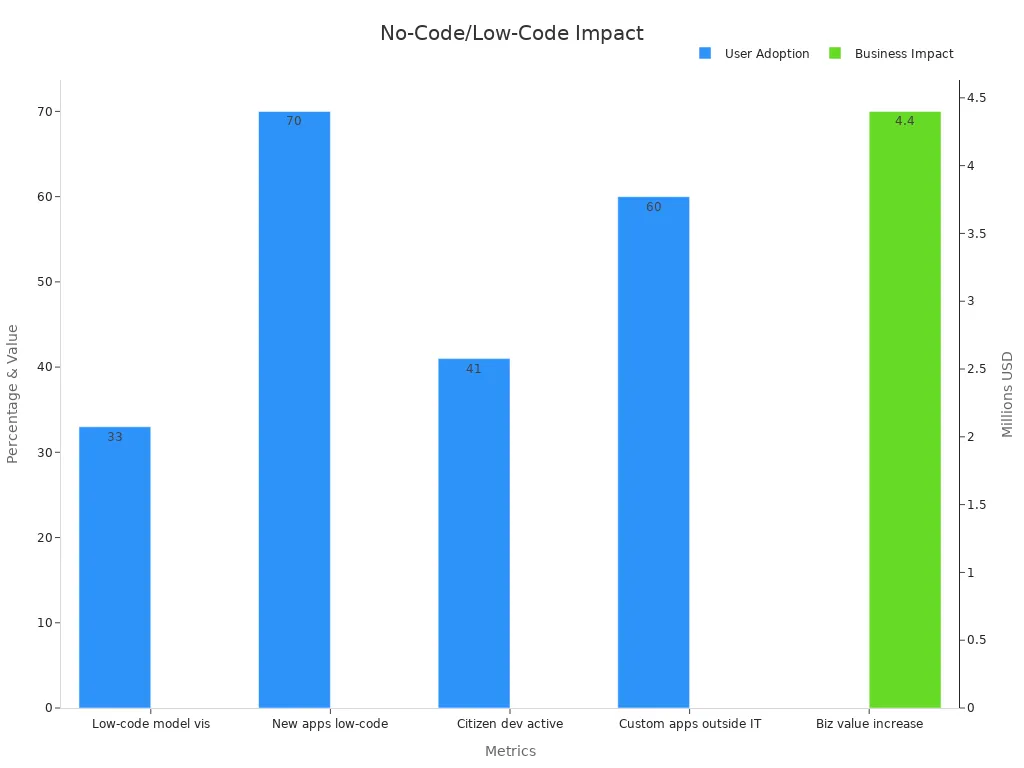How to Speed Up Product Development in 2025

In 2025, the ability to speed up product development is more crucial than ever. Customers are constantly seeking new ideas, and competitors are moving swiftly. If you can’t accelerate your product development, you risk falling behind. Consider this—how often does a brilliant idea fail simply because it arrives too late? Timing is everything.
Fortunately, companies like Upstack Studio demonstrate that it’s possible to address issues such as slow decision-making or vague strategies. The secret lies in balancing speed and quality while remaining adaptable in a rapidly evolving landscape.
Key Takeaways
Release products fast to stay ahead of others. Waiting too long can lose customers and money.
Start with a simple version (MVP) to test ideas early. This saves time and checks if people want it.
Use easy-to-build tools like no-code or low-code. These tools help you launch much faster.
Follow Agile methods to stay flexible and quick. This helps you make changes and meet customer needs better.
Use automation to handle boring tasks. This lets your team focus on creative and important work.
Why Speed to Market Matters in 2025
The need to launch faster than others
In 2025, launching products quickly is more important than ever. Companies that wait too long may lose their advantage. Why is this? The market rewards those who act fast. Businesses now test ideas and improve them quickly to stay ahead. Agile methods are common, helping teams work faster and smarter.
Imagine this—if your competitor releases a similar product first, they win. They get the attention, customers, and money. Companies also use data to pick the best time to launch. This way, they release products when people want them most. Quick updates to products help you reach more people and increase your company’s value. Today, being fast isn’t just helpful—it’s necessary.
The danger of bad timing
Timing can decide if a product succeeds or fails. If you launch too late, you might miss your chance. There are many examples of this. Nike’s FuelBand was delayed by six months, letting Fitbit take over the market. Amazon’s Fire Phone launched with old features, leading to bad sales and failure.
Studies show that being second to market often means getting only 60% of the first company’s share. That’s a big loss. To launch faster, you need to simplify your process and focus on what’s important. Missing the right time can cost you sales and hurt your reputation.
Why being flexible leads to success
Being flexible is key to winning in 2025. Markets change quickly, and so do customer needs. Companies that adjust fast stay successful. Ongoing research helps you see trends and change your product to match. This keeps your product useful and wanted.
Numbers also matter. By studying what customers like, you can focus on the most important features. This makes development faster and keeps customers happy. In a world where speed matters, being flexible helps you stay ahead.
Common Barriers to Speeding Up Product Development
Slow hiring and tired decision-makers
Hiring the right people can take too long. This delay slows down product development. If the same team makes all decisions, they get tired. Decision fatigue can cause burnout and slow progress. To fix this, hire faster and find skilled team members. A good team keeps your project moving smoothly.
Adding too much before testing
Adding too many features can hurt your product. Many startups fail because no one needs their product. Focus on a Minimum Viable Product (MVP) to test ideas early. MVP testing saves money and confirms demand. Too many features delay launches and hurt key functions. Keep it simple and test often to stay on track.
Redoing work due to unclear plans
Unclear plans can ruin your project. Without a clear scope, you waste time and money. Extra features can pile up, causing delays and high costs. Small changes can grow into big problems. This might drain your budget before finishing. Start with a clear plan to avoid costly mistakes. A clear scope keeps your project on time and budget.
Inefficient workflows and lack of automation
Does your team feel stuck in endless approvals and edits? That’s what happens with inefficient workflows, and they slow everything down. Without smooth processes, you waste time on repeated tasks and fixing mistakes. It’s annoying, right?
Here’s how bad workflows hurt your launch speed:
Waiting for approvals slows progress when too many people review tasks.
Messy documentation spreads info everywhere, causing confusion.
Doing the same data entry over and over wastes time and adds mistakes.
Poor communication between teams leads to delays and mixed-up goals.
Now, think about planning your schedule in this mess. It’s hard to know when tasks will finish. This can damage your reputation if deadlines are missed or quality drops. When team members leave, sharing knowledge becomes tough, slowing things even more.
Tip: Automation can save the day. Automating boring tasks lets your team focus on creative work. Tools like AI project software help organize communication, cut mistakes, and keep everyone aligned.
Bad workflows also raise labor costs. Fixing errors or redoing work takes extra hours. This pulls resources away from growth activities. The result? Slower launches and lost chances. To stay ahead, fix your workflows and use automation as much as you can.
Strategies to Speed Up Product Development
Use no-code and low-code platforms
To make products faster, try no-code and low-code tools. These tools help you build without needing to code much. Instead of waiting months, you can launch in days. Platforms like Momen are great for startups. They have ready-made templates, AI helpers, and custom options. This makes turning ideas into products super quick.
Did you know? No-code and low-code tools can cut development time by 90%. Forrester Research says they let developers build apps 10 times faster with 70% fewer resources.
These tools aren’t just fast—they’re flexible too. You can test ideas, get feedback, and make changes easily. Whether it’s an MVP or a tool for your team, no-code platforms keep you ahead in the market.
Try Agile and iterative methods
Agile methods are great for speeding up product work. Unlike old ways like the Waterfall model, Agile breaks projects into smaller parts. This lets you work on many tasks at once, saving time and effort.
Why does Agile work so well?
It gets customer feedback often, so you improve each step.
It’s flexible, so changes don’t mess up the whole project.
It overlaps building and testing, making launches quicker.
Agile isn’t just faster—it’s smarter. By involving your team and users, you make sure the product fits real needs. This boosts customer happiness and avoids costly mistakes.
Focus on quick feedback and user-first design
Quick feedback is key for faster product development. It helps you find problems early and fix them fast. By including users from the start, you make sure the product meets their needs. This speeds up the process and improves quality.
Here’s how to get faster feedback:
Talk to users early to learn what they want.
Get feedback often to catch issues quickly.
Use prototypes to test ideas and gather insights fast.
At first, this might seem like extra work. But it saves money and time later. You can make changes without big delays or extra costs. Plus, user-first design keeps your product useful and competitive.
Pro Tip: Tools like Momen and Upstack Studio make feedback easier. Momen’s no-code platform helps you test ideas fast. Upstack Studio helps scale your product as it grows.
By using these strategies, you’ll speed up development and lead in innovation.
Optimize workflows with automation and AI tools
Does your team spend too much time on boring tasks? Automation and AI tools can help. They make work faster, easier, and less stressful. This lets your team focus on creating new ideas.
Why are these tools so helpful?
They take care of simple jobs like entering data. Your team gets more time for creative tasks.
AI tools study data quickly and give smart advice. This helps you make better choices.
Automation keeps things consistent. It stops mistakes that waste time.
Check out these numbers to see how these tools improve work:
Improvement Area | Statistic |
|---|---|
Labor Efficiency Growth | 4.8 times better efficiency in industries using AI tools |
ROI from Smart Solutions | 30% to 200% return in the first year |
Hiring and Onboarding Speed | 67% faster hiring with AI automation |
Increase in Leads | 80% more leads with AI tools |
Conversion Rate | 75% higher conversion rates |
Qualified Prospects | 451% more qualified prospects |
Worker Performance Improvement | 40% better worker performance |
These numbers show how much automation and AI tools can help. Imagine hiring faster or making your team five times more efficient. That’s not just quicker—it’s smarter.
Tip: Start small. Pick one task, like scheduling or analyzing data, to automate. Once you see results, add more tools. Platforms like Zapier, Monday.com, and AI software can help you begin.
By fixing workflows, you’ll speed up launches and make your team happier.
Establish frequent milestones to maintain momentum
Big projects can feel overwhelming. Milestones help you stay organized and focused. They act like checkpoints to track progress and keep your team moving forward.
Why do milestones work so well?
They split big tasks into smaller steps. This makes work easier to manage.
They give clear goals, which keeps your team motivated.
They help spot problems early, saving time and effort.
Think of milestones as a map. Without them, you might get lost. With them, you know where you’re going and how far you’ve come. Teams that use milestones often finish projects faster and avoid delays.
Here’s how to use milestones:
Set clear and achievable goals for each step.
Celebrate small wins to keep spirits high.
Use tools like Trello or Asana to track progress and share updates.
Note: Milestones aren’t just for tracking. They help keep everyone on the same page, including stakeholders. This avoids confusion and keeps the project running smoothly.
By focusing on milestones, you’ll keep your team motivated and your project on schedule. It’s a simple way to stay organized and finish faster.
Tools and Technologies to Speed Up Product Launch
New no-code and low-code platforms
No-code and low-code tools are changing how products are made. These platforms let you create apps without needing to know coding. Instead of taking months, you can build products in just days. Tools like Momen offer ready-made templates, AI helpers, and options to customize. Whether it’s an MVP or a tool for your team, these platforms help you work faster.
Why are they so useful?
They make hard coding tasks simple for non-tech teams.
They let you test ideas quickly and get feedback fast.
They reduce the need for big coding teams, saving time.
By 2025, 70% of new apps will use low-code tools (Gartner). Businesses using these tools see big gains, like $4.4 million more value in three years (Forrester). Check out these numbers:
Metric Description | Value | Source |
|---|---|---|
Business value increase from low-code tools | $4.4 million over 3 years | Forrester |
New apps using low-code by 2025 | 70% | Gartner |
Companies with citizen developers | 41% | Gartner |

These tools also let non-IT workers, called "citizen developers," build apps. This helps your company launch products even faster.
AI-powered development and testing tools
AI is changing how we build and test products. Tools like GitHub Copilot can write code from simple instructions, saving time. AI testing tools go further by finding problems and creating test cases automatically. This means you can fix issues faster.
How do AI tools help?
Faster Testing: AI handles boring tasks, speeding up testing.
Better Accuracy: AI avoids human mistakes, giving reliable results.
Smarter Testing: AI focuses on risky areas, testing important features first.
Early Problem Detection: AI spots issues early, saving time and money.
Companies using AI tools report 20-40% faster work, fewer mistakes, and quicker launches. Here’s a summary of the benefits:
Benefit | Description |
|---|---|
Faster Testing | AI speeds up testing by automating repetitive tasks. |
Better Accuracy | AI avoids errors, improving test quality. |
Smarter Test Focus | AI tests the most important parts first. |
Early Problem Detection | AI finds issues early, saving time and resources. |
Cost Savings | AI lowers costs by reducing manual work and focusing resources on key tasks. |
Imagine running many tests at once or spotting problems before they happen. AI tools save time and improve product quality.
Teamwork and project management tools
Good teamwork is key to fast product development. Tools like Monday.com, Trello, and Asana make it easier to manage tasks and communicate. They keep everyone on the same page, avoiding delays from confusion.
How do these tools help?
Work Together Anywhere: Teams can collaborate in real-time, even remotely.
Clear Progress: Everyone sees updates and knows their tasks.
Better Task Tracking: No more lost feedback or version mix-ups.
For example, tracking tasks in real-time helps you spot problems early. Automatic updates show where delays happen, so you can fix them fast. These tools keep your team focused and your project on schedule.
Tip: Start with a simple tool like Trello. As your team grows, try advanced tools like Monday.com for more features and automation.
Using these technologies helps you launch products faster without losing quality.
Data-driven decision-making tools
In 2025, data is your best tool for faster product development. With helpful tools, you can make better decisions quickly. These tools don’t just show numbers—they explain what works, what doesn’t, and what to do next. Let’s see how they can improve your process.
Why data-driven tools matter
Imagine having instant updates to guide your actions. Data-driven tools let you fix problems as they happen. For example, if users find an issue, you can solve it right away. These tools also help you guess what customers want, so you can launch at the right time. That’s not just smart—it’s a game-changer.
Here’s how they help:
Use live data to fix issues fast.
Improve teamwork by automating tasks and sharing updates.
Predict customer needs to plan better launches.
By using these tools, you’ll save time, avoid errors, and stay ahead of others.
Key benefits of data-driven tools
These tools are not only fast—they’re flexible and save money too. They adjust to your needs and work with other tools you already use. Plus, they’re affordable. Here’s what they offer:
Scalability: Add resources as your project grows.
Flexibility: Work with tools like project software or AI platforms.
Cost-effectiveness: Save money while working faster.
Accessibility: Share live data with teams for better teamwork.
When everyone sees the same data, decisions are quicker and more accurate. This keeps your projects on track.
How to get started
You don’t need to be a data expert to begin. Start small. Focus on one area, like tracking user feedback or market trends. Tools like Tableau or Google Analytics make it easy to see patterns in data. Once you see results, expand to other areas.
Pro Tip: Combine data-driven tools with automation. For example, use AI to study customer behavior and suggest changes. This saves time and ensures your product fits user needs.
By using data-driven decision-making, you’ll speed up development and create products people love. It’s a win-win for your team and customers.
Case Studies of Faster Time-to-Market Success

A startup using no-code for quick MVP launch
Think about a startup wanting to launch fast. That’s what SuperQueer did by using no-code tools. They gained 276 active users with a 72% engagement rate. ToyCycle grew 30% every month, and StraightUp Collective improved efficiency by 30%. These startups prove no-code tools help you launch quickly without needing coding skills.
Startup | Active Users | Engagement Rate | Month-over-Month Growth | Parent Satisfaction Rate | Operational Efficiency Boost |
|---|---|---|---|---|---|
SuperQueer | 276 | 72% | N/A | N/A | N/A |
ToyCycle | N/A | N/A | 30% | 90% | N/A |
StraightUp Collective | N/A | N/A | N/A | N/A | 30% |
A mid-sized company using AI to improve workflows
For mid-sized companies, AI tools are a big help. They cut manual work by 30-50%, letting teams focus on important tasks. AI-powered workflows boost efficiency and improve customer experiences without big costs. By connecting with tools like Slack and Jira, AI makes task assignments and approvals faster, saving 20-40% on labor costs. This makes operations smoother and speeds up product launches.
Evidence Description | Impact on Workflows |
|---|---|
Businesses using AI agents see a 30-50% reduction in manual workload. | Allows teams to focus on higher-value work. |
AI-powered workflows improve efficiency and customer experiences without major investment. | Enhances overall productivity in mid-sized companies. |
AI integrates with tools like Slack, Jira, and Salesforce to automate workflows. | Streamlines task assignments and approvals. |
AI reduces manual workload, saving 20-40% in labor costs. | Directly impacts operational costs and efficiency. |
A large company adopting Agile to speed up launches
Big companies like John Deere and VistaPrint use Agile to launch faster. John Deere boosted output by 125% and cut time to market by 40%. VistaPrint reduced release cycles from 18 months to 3 weeks. They also cut lead times from 8 weeks to 9 days. FitBit used SAFe to scale Agile, launching 4 products and shipping 22 million devices in one year. These examples show how Agile helps companies stay ahead.
John Deere increased output by 125%.
Cut time to market by 40%.
Improved engineering ratio to 75%.
Employee NPS improved by 20 points.
Labor costs dropped by 20%.
VistaPrint reduced release cycles from 18 months to 3 weeks.
Lead times dropped from 8 weeks to 9 days.
Cycle times went from 2 weeks to 4 days.
FitBit scaled Agile with SAFe.
Met goals ahead of schedule.
Launched 4 products and shipped 22 million devices in one year.
To make products faster, use smart strategies to stay ahead. Focus on creating new ideas and learning what customers want. Support creative thinking and work with others to share tools and ideas. Here’s a simple breakdown of these strategies:
Strategy Type | What It Means |
|---|---|
Active Product Creation | Companies work on new ideas early to beat competitors. |
Learning About Customers | Research helps find out what people need and want. |
Research and Development | Use R&D to make better products that meet customer needs. |
Supporting Creativity | Let employees try new ideas and learn from mistakes. |
Teaming Up | Partner with others to share tools and lower risks. |
Buying Other Companies | Join with or buy companies to get new tools and reach more people. |
Being flexible, creative, and working together are key to success. By using these ideas, you can make products faster and stay ahead. Don’t wait—start trying these strategies now to stay competitive and creative!
FAQ
What is the fastest way to test a product idea?
Start with a Minimum Viable Product (MVP). It’s a simple version of your product that lets you test core features. Use no-code tools to build it quickly. Gather feedback from users early to refine your idea.
Tip: Platforms like Momen or Bubble can help you create MVPs in days.
How can automation speed up product development?
Automation handles repetitive tasks like data entry or testing. This frees up your team to focus on creative work. Tools like Zapier or AI-powered platforms streamline workflows, reduce errors, and save time.
Example: Automating approvals can cut delays by 30%.
Are Agile methods suitable for small teams?
Absolutely! Agile works well for teams of any size. It breaks projects into smaller tasks, making them easier to manage. Small teams benefit from frequent feedback and flexibility, which keeps projects on track.
What’s the best way to avoid delays in product launches?
Set clear milestones and stick to them. Break your project into smaller steps with deadlines. Use project management tools like Trello or Monday.com to track progress and keep everyone aligned.
Do no-code tools work for complex products?
Yes, but with limits. No-code tools are great for building prototypes or simple apps. For complex products, they can handle parts of the process, like front-end design, while developers focus on advanced features.
Note: Combine no-code tools with traditional coding for the best results.
See Also
12 Strategies for Integrating AI into Your SaaS by 2025
Launching a Successful Startup in 2025: A Complete Guide
10 Innovative SaaS Business Concepts to Start in 2025
7 Effective Strategies for Managing Rapidly Growing Startups

